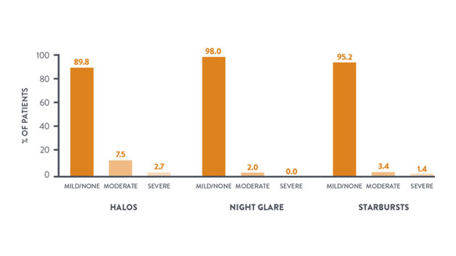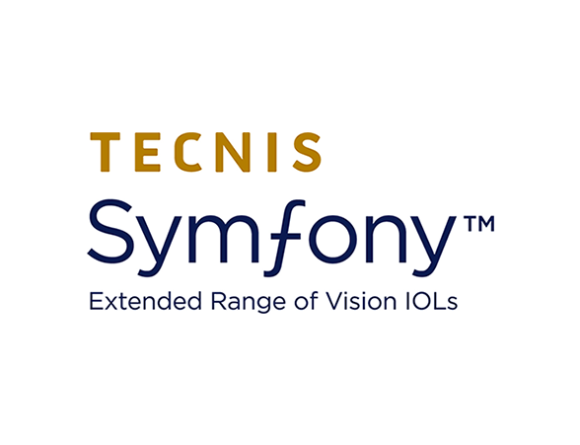TECNIS SymfonyTM IOL
TECNIS SymfonyTM IOL
To order this product, please contact your sales rep.
Instructional Guides
Instructional Guides
Instructional Guides
Seamless Brilliance
The TECNIS SymfonyTM IOL mitigates the effects of presbyopia so you can empower your patients to see clearly across the full range of vision.1
Leading Innovation. High-Quality Vision. Exceptional Satisfaction.
Delivering excellent uncorrected visual acuity (VA) at all distances,
the TECNIS SymfonyTM IOL allows your patients to see clearly across a full range of vision.1
Defocus Curve2
6-Month Data, Bilaterally Implanted Subjects

- Sustained 20/25 or better mean VA through 1.5 D
- Sustained 20/40 or better mean VA through 2.5 D
- Increase of 1.0 D range of vision throughout the defocus curve
Rather than splitting light into distinct focal points,
the TECNIS SymfonyTM IOL elongates focus, resulting in an increased depth of field. This empowers you to deliver a full range of continuous vision while maintaining high image contrast.1
Monocular Contrast Sensitivity at 6 Months2
Mesopic without Glare

Deliver the visual quality that allows your patients with and without astigmatism to see clearly in any lighting condition.
- High-quality distance vision in the presence of astigmatism1
- Pupil-independent performance enables optimal performance in any lighting condition1
- Low overall spectacle wear1
The TECNIS SymfonyTM IOL delivers 20/20 or better vision through 1.5 D of astigmatism.2
85% of patients wear glasses none or a little bit of the time.2
By combining a unique diffractive pattern with achromatic technology,
the TECNIS SymfonyTM IOL delivers outstanding visual acuity over a continuous range of distances while maintaining high contrast performance.1
- Proprietary relief profile elongates focus1
- Proprietary achromatic technology corrects chromatic aberration and enhances image contrast1
Degree of Difficulty with Visual Symptoms3
Percentage of Eyes, Non-Directed Reports, 6 Months Postoperative

Low incidence of visual symptoms, including halos, glare and starbursts1
Unlike another leading IOL, TECNISTM IOL material is not associated with
glistenings,4-8 which can inhibit your patients’ vision. Glistenings cause light scatter, which can result in a reduction in image contrast.5-9
|
Model: |
ZXR00 |
|
|
OPTIC CHARACTERISTICS1 |
||
|
Diameter: |
6.0 mm |
|
|
Center Thickness: |
0.7 mm (20.0 D) |
|
|
Shape: |
Biconvex, wavefront-designed anterior aspheric surface, posterior achromatic diffractive surface designed to reduce chromatic aberration for enhanced image contrast and echelette feature to extend the range of vision. |
|
|
Material: |
UV-absorbing hydrophobic acrylic |
|
|
Refractive Index: |
1.47 at 35° C |
|
|
Edge Design: |
ProTEC frosted, continuous 360° posterior square edge |
|
|
BIOMETRY* |
CONTACT ULTRASOUND |
OPTICAL |
|
A-Constant: |
118.8 |
119.3 |
|
Theoretical AC Depth: |
5.40 mm |
5.7 mm |
|
Surgeon Factor:10 |
1.68 mm |
1.96 mm |
|
HAPTIC CHARACTERISTICS1 |
||
|
Overall Diameter: |
13.0 mm |
|
|
Thickness: |
0.46 mm |
|
|
Style: |
C |
|
|
Material: |
Soft, foldable, UV-absorbing hydrophobic acrylic |
|
|
Design: |
TRI-FIX, haptics offset from optic, one-piece lens |
|
View full product specifications (PDF)
IOL INSERTION
Recommended insertion instruments:
- UNFOLDERTM Platinum 1 Series Delivery System: Intuitive push-and-twist, screw-style insertion designed to simplify lens implantation.
FOOTNOTES
*Value theoretically derived for a typical 22.0 D lens. Johnson & Johnson Vision recommends that surgeons personalize their A-constant based on their surgical techniques and equipment, experience with the lens model and postoperative results.
REFERENCES
© Johnson & Johnson Surgical Vision, Inc. 2022.
For healthcare professionals only. Please reference the Instructions for Use for a complete list of Indications and Important Safety Information and contact our specialists in case of any question
PP2022MLT4205

